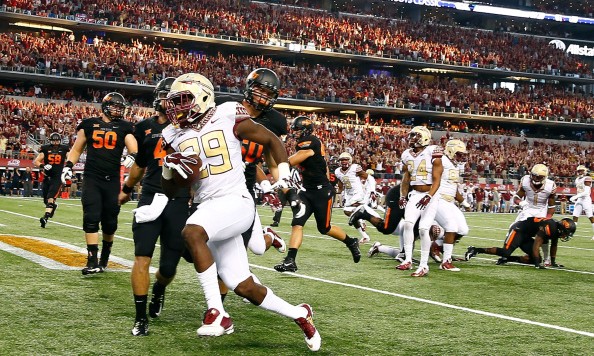Perhaps the most unexpected change from 2013 to 2014 was the dramatic decline from the Florida State defense. Both the run and pass defense suffered setbacks that were not only seen on the field, but illustrated in the numbers.
After being ranked fourth in both rushing S&P and passing S&P in 2013, the Seminoles slid down to 50th last season. This was despite having multiple draft picks in both the secondary and on the defensive line.
While the defense didn’t lose any games for FSU except to Oregon in the Rose Bowl, this season may need the defense to win games for FSU. Florida State no longer has quarterback Jameis Winston to bail it out.
Having running back Dalvin Cook and others back will help alleviate the load, but the defense will have to step up if it wants to compete for an ACC championship. With that in mind, here are three aspects of the defense that can (and hopefully for FSU will) be improved this season:
1. More sacks
There’s just no getting around it. FSU was abysmal at getting to the quarterback in 2014 and the talent on the roster did not reach its full potential. With a grand total of 17 sacks in 2014, Florida State was tied for 108th in the nation last year overall and was even worse on a per game basis (114th).
Eddie Goldman had the most sacks of anyone on the defensive line, and he was a defensive tackle. Coaches are hoping that a group consisting of Jacob Pugh, DeMarcus Walker, Lorenzo Featherston, Chris Casher, Rick Leonard, and Josh Sweat will be able to at least improve on the numbers from the previous season. The talent is there at the very least.
Some good news regarding this aspect is that FSU hired former Florida defensive ends coach Brad Lawing to come in and help on the line. With a group that is fairly young like this one, Lawing will hopefully develop it into what it has the potential to be. FSU will be running nickel and dime defensive packages that will be helped immensely if the line can penetrate early and often. If the Seminoles want to emerge victorious against teams like Clemson with Deshaun Watson or Miami with Brad Kaaya, they must be able to force the quarterback into quick and eventually bad decisions.
2. Cohesive secondary play
Jalen Ramsey is one of the best defensive backs in the nation and will most likely be responsible for a couple of wins by himself this year. Unfortunately, Florida State is unable to clone him and get five more Ramsey’s in the secondary. Thankfully, the Seminoles have recruited extremely well and have a mixture of both veterans and newcomers. Guys like Lamarcus Brutus, Tyler Hunter, and Nate Andrews bring experience while Trey Marshall and Derwin James look to get serious reps. Add in various corners like Marquez White and Tarvarus McFadden, and Florida State is definitely not lacking in pass coverage.
As seen last year however, talent doesn’t always translate to exceptional defense on the field. Despite having both Ronald Darby and P.J. Williams, Florida State’s pass defense surrendered almost 226 yards per game and ranked 59th nationally in this category. Quarterbacks like Jacoby Brisset, Deshaun Watson, and Everett Golson all looked like Heisman contenders at some points against the Seminoles.
As mentioned in the previous point, FSU plans to switch it up a little more this year and use five or six defensive backs in order to play to its strengths or alternatively, cover its weaknesses. Neither Hunter nor Andrews were especially impressive at the safety position last year, so the team hopes that the new focus will help both of them. A lot of talk has been about putting Andrews at the “Money” position with the defense and it’s hard to see how he won’t succeed with such a placement.
3. Relatively healthy year
This is admittedly more a crap-shoot than the other two factors, but staying healthy is arguably the most important. The 2013 national championship season was very rare in that FSU didn’t have any major injuries to its starters, save Tyler Hunter. Fans were brought back down to earth in 2014 when players like Nile Lawrence-Stample, Matthew Thomas, Mario Edwards Jr. and Eddie Goldman all got hurt and were out for various periods of time. Yes, the Seminoles were and still are talented, but any injury to a starter or heavy rotational player will greatly affect the game plan.
FSU enters 2015 with an already thin position groups at linebacker and defensive tackle — an issue that the coaches will certainly pay close attention to. Unfortunately for teams, injuries are largely out of their control. If the Seminoles can survive the year without losing one of their starters for an extended amount of games, they will again be in contention for the ACC championship. Should they experience a couple of major setbacks, it will show up in the win-loss column.




















